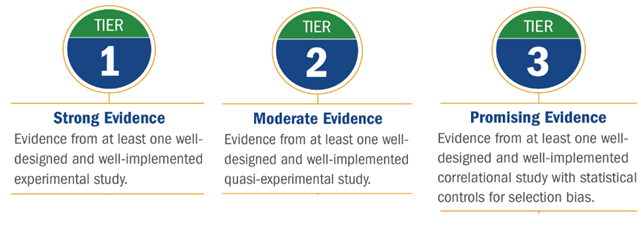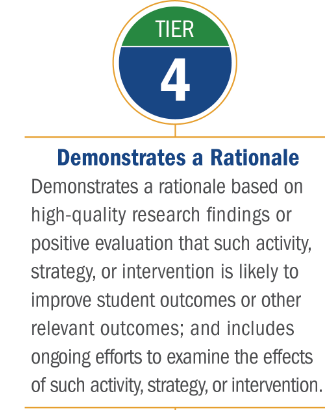Leveraging Evidence-Based Practices for Local School Improvement
Evidence-based practices (EBPs) – which include activities, strategies, and interventions – are “derived from or informed by objective evidence—most commonly, educational research or metrics of school, teacher, and student performance” (Glossary of Education Reform 2016(link is external)). Using, generating, and sharing evidence gives stakeholders an important tool to accelerate student learning. By using rigorous and relevant evidence and assessing the local capacity to implement the intervention (e.g., funding, staff, staff skills, stakeholder support), states and districts are more likely to implement successful school improvement interventions (U.S. Department of Education 2016(link is external)). The Elementary and Secondary Education Act of 1965 (ESEA), as amended by the Every Student Succeeds Act (ESSA), gives states and districts flexibility in choosing EBPs. This allows states and districts to prioritize the practices most likely to yield positive outcomes while also supporting the use of promising evidence that may be the best fit for local needs.
 Identifying EBPs is one part of a broader improvement process, which is outlined in the U.S. Department of Education’s (ED’s) Non-Regulatory Guidance: Using Evidence to Strengthen Education Investments(link is external). This guide describes how identifying local needs informs the selection of interventions that are implemented, examined, and refined over time. The State Support Network’s Needs Assessment Guidebook provides more useful information on how to identify the local challenges and the root cause of those challenges. Using this process to select EBPs targeted to local needs can help states, districts, and schools make the best use of ESEA investments to support better outcomes for students. This process can also help schools identified for comprehensive or targeted support and improvement to make meaningful changes for their students.
Identifying EBPs is one part of a broader improvement process, which is outlined in the U.S. Department of Education’s (ED’s) Non-Regulatory Guidance: Using Evidence to Strengthen Education Investments(link is external). This guide describes how identifying local needs informs the selection of interventions that are implemented, examined, and refined over time. The State Support Network’s Needs Assessment Guidebook provides more useful information on how to identify the local challenges and the root cause of those challenges. Using this process to select EBPs targeted to local needs can help states, districts, and schools make the best use of ESEA investments to support better outcomes for students. This process can also help schools identified for comprehensive or targeted support and improvement to make meaningful changes for their students.
The main indicator of quality for EBPs (including specific interventions, activities and strategies implemented at the school or district levels) should be clear evidence of impact based on rigorous research. In short, proven impact in rigorous research should be the main indicator of quality for EBPs used to support schools and districts in improving student achievement. Where the ESEA requires states, districts and schools to use EBPs, it generally requires that the EBP fall under one of four tiers of evidence. EBPs funded under Section 1003 (School Improvement) of the ESEA, as amended by the ESSA, are required to have strong, moderate, or promising evidence (Tiers 1-3 out of the four tiers).1 All other programs under Titles I-IV can leverage Tiers 1-3 as well as Tier 4.
This online resource is designed to help districts identify EBPs within each of these categories as part of ESEA implementation. To learn more, click anywhere on Tiers 1-3 or on Tier 4.
RESOURCES FROM THE FIELD
ESSA Action Guide: Selecting Evidence-Based Practices for Low-Performing Schools(link is external) This report from American Institutes for Research focuses on the use of evidence-based practices, with the goal of helping leaders at the state, district, and school levels explore and select interventions designed to support school improvement.
Better Evidence, Better Choices, Better Schools: State Supports for Evidence-Based School Improvement and the Every Student Succeeds Act(link is external) This report from the Center for American Progress provides information for states on the ESEA, as amended by ESSA, definition of EBPs and clarifies the distinction between the ESSA definition of the term and the term “scientifically based research,” which was included in multiple provisions under the ESEA, as amended by No Child Left Behind. The report also offers an approach for states to consider when selecting and implementing EBPs.
Evidence-Based Improvement: A Guide for States to Strengthen Their Frameworks and Supports Aligned to the Evidence Requirements of ESSA(link is external) This guide from WestEd provides six tools(link is external) to help states and districts understand and plan for implementing evidence-based improvement strategies. The tools help states and districts inventory current practices and decide how to select new practices using a step-by-step process.
Evidence Building Opportunities Under ESSA(link is external) This guide from Chiefs for Change and Results For America outlines the policies and practices states can leverage to use EBPs, build an evidence base and use evidence to improve outcomes for students.
1 More information on the four tiers of evidence and the criteria associated with each can be found in ED’s Non-Regulatory Guidance:Using Evidence to Strengthen Education Investments(link is external)



